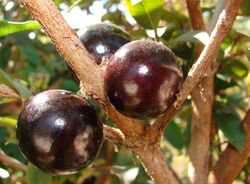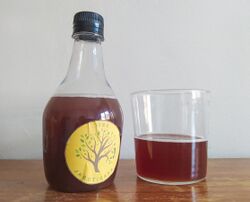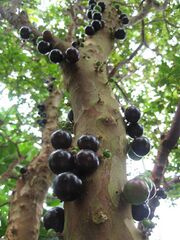Biology:Jabuticaba
| Jabuticaba | |
|---|---|

| |
| Scientific classification | |
| Kingdom: | Plantae |
| Clade: | Tracheophytes |
| Clade: | Angiosperms |
| Clade: | Eudicots |
| Clade: | Rosids |
| Order: | Myrtales |
| Family: | Myrtaceae |
| Genus: | Plinia |
| Species: | P. cauliflora
|
| Binomial name | |
| Plinia cauliflora (Mart.) Kausel
| |
| Synonyms[2] | |
| |
Jabuticaba (pt-BR), also spelled Jaboticaba,[3] is the edible fruit of the jabuticabeira (Plinia cauliflora) or Brazilian grapetree. The purplish-black, white-pulped fruit grows directly on the trunk of the tree, making it an example of 'cauliflory'. It is eaten raw or used to make jellies, jams, juice or wine.[4] The tree, of the family Myrtaceae, is native to the states of Rio de Janeiro, Minas Gerais, Goiás and São Paulo in Brazil.[5][6] Related species in the genus Myrciaria, often referred to by the same common names, are native to Brazil , Argentina , Paraguay, Peru and Bolivia.[7]
Etymology
The name jabuticaba derives from the Tupi word îaboti Lusitanized jaboti/jabuti (tortoise) + kaba (place), meaning "the place where tortoises are found";[8] it has also been interpreted to mean 'like turtle fat', referring to the fruit's white pulp.[9][10][11] It could also derive from ïapotï'kaba meaning "fruits in a bud".[12]
The Guarani name is yvapurũ: yva means fruit and the onomatopoeic word purũ, from pururũ,[13] describes the crunching sound the fruit produces when bitten.[14]
Description
Plant
The tree is a slow-growing evergreen that can reach a height of 15 meters if not pruned. The leaves are salmon-pink when young, turning green as they mature.[15]
The tree prefers moist, rich, lightly acidic soil. It is widely adaptable, however, and grows satisfactorily even on alkaline beach-sand type soils, so long as it is tended and irrigated. Its flowers are white and grow directly from its trunk in a cauliflorous habit.[16] In its native habitat jaboticabeiras may flower and fruit 5-6 times throughout the year. Jabuticabeira are tropical to subtropical plants and can tolerate mild, brief frosts, not below 26 °F (-3 °C).[9]
The tree has a compact, fibrous root system, that makes it suitable for growing in pots or transplanting.[17]
Fruit
The fruit is a thick-skinned berry and typically measures 3–4 cm in diameter. The fruit resembles a slip-skin grape. It has a thick, purple, astringent skin that encases a sweet, white or rosy pink gelatinous flesh. Embedded within the flesh are one to four large seeds, which vary in shape depending on the species.[18] Jabuticaba seeds are recalcitrant and they become unviable within 10 days when stored at room temperature.[19]
In Brazil, the fruit of several related species, including Myrciaria tenella and Plinia peruviana, share the same common name.[20]
Production and cultivation
Jabuticaba has been cultivated in Brazil since pre-Columbian times. Today it is commercial crop in the center and south of the country.[21]
Commercial cultivation of the fruit in the northern hemisphere is more restricted by slow growth and the short shelf-life of fruit than by temperature requirements.[22] Grafted plants may bear fruit in five years, while seed-grown trees may take 10 to 20 years to bear fruit.[19]
Jabuticabeiras are fairly adaptable to various kinds of growing conditions, tolerating sand or rich topsoil. They are intolerant of salty soils or salt spray.[23] They are tolerant of mild drought, though fruit production may be reduced, and irrigation will be required in extended or severe droughts.[20]
Jabuticabeiras are vulnerable to the rust, Austropuccinia psidii.[24] particularly when the tree flowers during heavy rain. Other important diseases that affect jabuticabeiras are canker (Colletotrichum gloeosporioides), dieback (Rosellinia), and fruit rot (Botrytis cinerea).[25]
Uses
Culinary
Common in Brazilian markets, jabuticabas are largely eaten fresh.[26] Fruit may begin to ferment 3 to 4 days after harvest, so it is often used to make jams, tarts, strong wines, and liqueurs. Due to the short shelf-life, fresh jabuticaba is rare in markets outside areas of cultivation.[21]
The fruit has been compared to Muscadine grapes,[17] and in Japan the flavor of jabuticaba has been described as similar to that of Kyoho grapes.[27]
Bonsai
Their slow growth and small size when immature make jabuticabeiras popular as bonsai or container ornamental plants in temperate regions.[28] It is a widely used bonsai species in Taiwan and parts of the Caribbean.[29]

Cultural significance
The jabuticabeira appears as a charge on the coat of arms of Contagem, Minas Gerais, Brazil .[31]
In Brazilian politics, and less commonly in everyday speech, "jabuticaba" is a slang that describes a political or legal setting that is considered absurd, unusual, or needlessly complex, among others, that could only exist in a country like Brazil. It is a reference to the popular wisdom that jabuticaba trees can only grow in Brazil.[32][33]
Related species
There are a number of similar species of plant in the family Myrtaceae that produce fruit that is known by the common name Jabuticaba.[20][26]
- Myrciaria glazioviana (jabuticaba amarela or yellow jabuticaba)
- Myrciaria tenella (jabuticaba macia or soft jabuticaba)
- Plinia coronata (jabuticaba coroada or king jabuticaba)
- Plinia grandifolia (jabuticaba graúda or large jabuticaba)
- Plinia martinellii (jabuticabinha da mata or little forest jabuticaba)
- Plinia oblongata (jabuticaba azeda or sour jabuticaba)
- Plinia peruviana (jabuticaba cabinho or small stemmed jabuticaba)
- Plinia phitrantha (jabuticaba branca or white jabuticaba)
- Plinia rivularis (jabuticaba de cacho or bunched jabuticaba)
- Plinia spirito-santensis (jabuticaba peluda de cruz, hairy cross jaboticaba, or grimal in the United states).
References
- ↑ "Plinia cauliflora (Mart.) Kausel". https://www.gbif.org/species/5415571.
- ↑ The Plant List: A Working List of All Plant Species, http://www.theplantlist.org/tpl1.1/record/kew-161353, retrieved 23 April 2016
- ↑ Popenoe, Wilson (July 1914). "The Jaboticaba". Journal of Heredity 5 (7): 321. https://www.biodiversitylibrary.org/item/45076#page/340/mode/1up. Retrieved 14 December 2023.
- ↑ "Marianna shares Brazilian treegrape jam recipe". Bundaberg Now. 23 August 2020. https://www.bundabergnow.com/2020/08/23/mariannas-homemade-jams-are-a-real-treat/.
- ↑ {{citation | mode = cs1 | title = Jabuticaba | work = Germplasm Resources Information Network (GRIN) | url = | publisher = [[Organization:Agricultural Research ServAgricultural Research Service (ARS), United States Department of Agriculture (USDA) | access-date = 2016-04-23 }}
- ↑ Pimentel Gomes (1973) (in pt-br). Fruticultura brasileira. Nobel. pp. 263–368. ISBN 9788521301264. https://books.google.com/books?id=ww8sJUp-rVEC&pg=PA263.
- ↑ "Brazilian grapetree". https://www.edenproject.com/learn/for-everyone/plant-profiles/brazilian-grapetree.
- ↑ Rodrigues, Sueli; de Oliveira Silva, Ebenezer (January 5, 2018). Exotic Fruits Reference Guide. Academic Press. p. 237. ISBN 9780128031537.
- ↑ 9.0 9.1 "Plinia cauliflora". http://www.missouribotanicalgarden.org/PlantFinder/PlantFinderDetails.aspx?taxonid=302521.
- ↑ Love, Ken; Paull, Robert E. (June 2011). "Jaboticaba". University of Hawaiʻi at Mānoa College of Tropical Agriculture and Human Resources. https://www.ctahr.hawaii.edu/oc/freepubs/pdf/F_N-20.pdf.
- ↑ Navarro, Eduardo de Almeida (2013). Dicionário de tupi antigo: a língua indígena clássica do Brasil. São Paulo. Global. p. 152.
- ↑ Ferreira, A. B. H. (1986). Novo Dicionário da Língua Portuguesa (second ed.). Rio de Janeiro: Nova Fronteira. p. 977.
- ↑ Reduplication in Indigenous Languages of South America. Brill's Studies in the Indigenous Languages of the Americas. 7. Brill. April 17, 2014. p. 22974. ISBN 978-90-04-27241-5.
- ↑ "Yvapurũ, guapuru, jabuticaba". https://www.jungledragon.com/image/35777/yvapur_guapuru_jabuticaba.html.
- ↑ Marchiori, Jose Newton Cardosa; Sobral, Marcos (1997) (in pt). Dendrologia das angiospermas: Myrtales. Federal University of Santa Maria. p. 304. ISBN 9788573910094.
- ↑ Brown, Stephen H.. "Myrciaria cauliflora: Jaboticaba; Brazilian grapetree; jabuticaba; ybapuru" (pdf). University of Florida Institute of Food and Agricultural Sciences. https://www.deerfield-beach.com/DocumentCenter/View/13948.[yes|permanent dead link|dead link}}]
- ↑ 17.0 17.1 Margaret Barwick (2004). Tropical & Subtropical Trees: An Encyclopaedia. Timber Press. p. 290. ISBN 978-0881926613.
- ↑ Boning, Charles (2006). Florida's Best Fruiting Plants: Native and Exotic Trees, Shrubs and Vines. Sarasota, Florida: Pineapple Press, Inc.. p. 104.
- ↑ 19.0 19.1 Antonio Alberto da Silva1, José; Henrique de Almeida Teixeira, Gustavo; Baldo Geraldo Martins, Antonio; Citadin, Idemir; Wagner Júnior, Américo; Andrigo Danner, Moeses (July 1, 2019). "Advances in the propagation of Jabuticaba tree". Revista Brasileira de Fruticultura 41 (3). doi:10.1590/0100-29452019024.
- ↑ 20.0 20.1 20.2 Duarte, Odilo; Paull, Robert (2015). Exotic Fruits and Nuts of the New World. Centre for Agriculture and Bioscience International. p. 51. ISBN 9781780645056. https://books.google.com/books?id=XuluBgAAQBAJ&pg=PA51.
- ↑ 21.0 21.1 Hernández Bermejo, J. Esteban; León, J. (1994). Neglected crops: 1492 from a different perspective.. Food and Agriculture Organization of the United Nations. p. 229. ISBN 9789251032176.
- ↑ Suívie (November 10, 2020). "What are jabuticaba berries? Six things you need to know". https://www.nationalgeographic.co.uk/travel/2020/10/what-are-jabuticaba-berries-six-things-you-need-to-know.
- ↑ Van Atta, Marian (2002). Exotic Foods A Kitchen and Garden Guide. Pineapple Press. p. 78. ISBN 9781561642151.
- ↑ "Spots on Fruit and Flowers". https://cms.ctahr.hawaii.edu/uhmgpd/Diagnose/Fruits/Jaboticaba/Spots-on-fruit-and-flowers.
- ↑ de Almeida Teixeira, G.H.; Berlingieri Durigan, M.F.; Durigan, J.F. (2011). "11 - Jaboticaba (Myrciaria cauliflora (Mart.) O.Berg. [Myrtaceae])". Postharvest Biology and Technology of Tropical and Subtropical Fruits: Cocona to Mango. Woodhead Publishing Series in Food Science, Technology and Nutrition. Woodhead Publishing Series in Food Science, Technology and Nutrition. pp. 246–274. doi:10.1533/9780857092885.246. ISBN 9781845697358. https://www.sciencedirect.com/science/article/pii/B9781845697358500115.
- ↑ 26.0 26.1 The Encyclopedia of Fruit & Nuts. Centre for Agriculture and Bioscience International. 2008. p. 536. ISBN 9780851996387. https://books.google.com/books?id=cjHCoMQNkcgC&pg=PA536.
- ↑ Baseel, Casey (20 December 2013). "Are these grapes growing on a tree trunk? Nope! They're Jabuticaba, the otherworldly fruit with an awesome name". Sora News 24. https://soranews24.com/2013/12/21/are-these-grapes-growing-on-a-tree-trunk-nope-theyre-jabuticaba-the-otherworldly-fruit-with-an-awesome-name/.
- ↑ Bender, Richard (January 13, 2015). Bountiful Bonsai: Create Instant Indoor Container Gardens with Edible Fruits, Herbs and Flowers. Tuttle Publishing. p. 59. ISBN 9781462916221.
- ↑ Lim, T.K. (February 9, 2012). Edible Medicinal And Non Medicinal Plants: Volume 3, Fruits. Springer Netherlands. p. 669. ISBN 9789400725348.
- ↑ Motta, Débora (April 8, 2019). Vinho artesanal de jabuticaba: uma alternativa para o desenvolvimento do Noroeste Fluminense Fundação Carlos Chagas Filho de Amparo à Pesquisa do Estado do Rio de Janeiro in Portuguese. Retrieved June 26, 2023.
- ↑ Brazilian Flags
- ↑ "Jabuticaba Política". Istoé. 2013-05-15. https://istoe.com.br/297651_JABUTICABA+POLITICA/.
- ↑ "A jabuticaba e os vira-latas nacionais". Valor Econômico. 2012-10-22. http://www.valor.com.br/brasil/2874126/jabuticaba-e-os-vira-latas-nacionais. ""Existe só no Brasil e não é jabuticaba? Não presta". Poucos ditados concentram tão bem, em mensagem tão convincente, uma ideia tão equivocada. Translation: "Does it exist only in Brazil and is it not a jabuticaba? It is no good.""
External links
| Wikimedia Commons has media related to Plinia cauliflora. |
- Jaboticaba California Rare Fruit Growers.
- Popenoe, Wilson (July 1914). "The Jaboticaba". Journal of Heredity. 5 (7): 318-326 via Biodiversity Heritage Library.
Wikidata ☰ Q1973619 entry
 |





